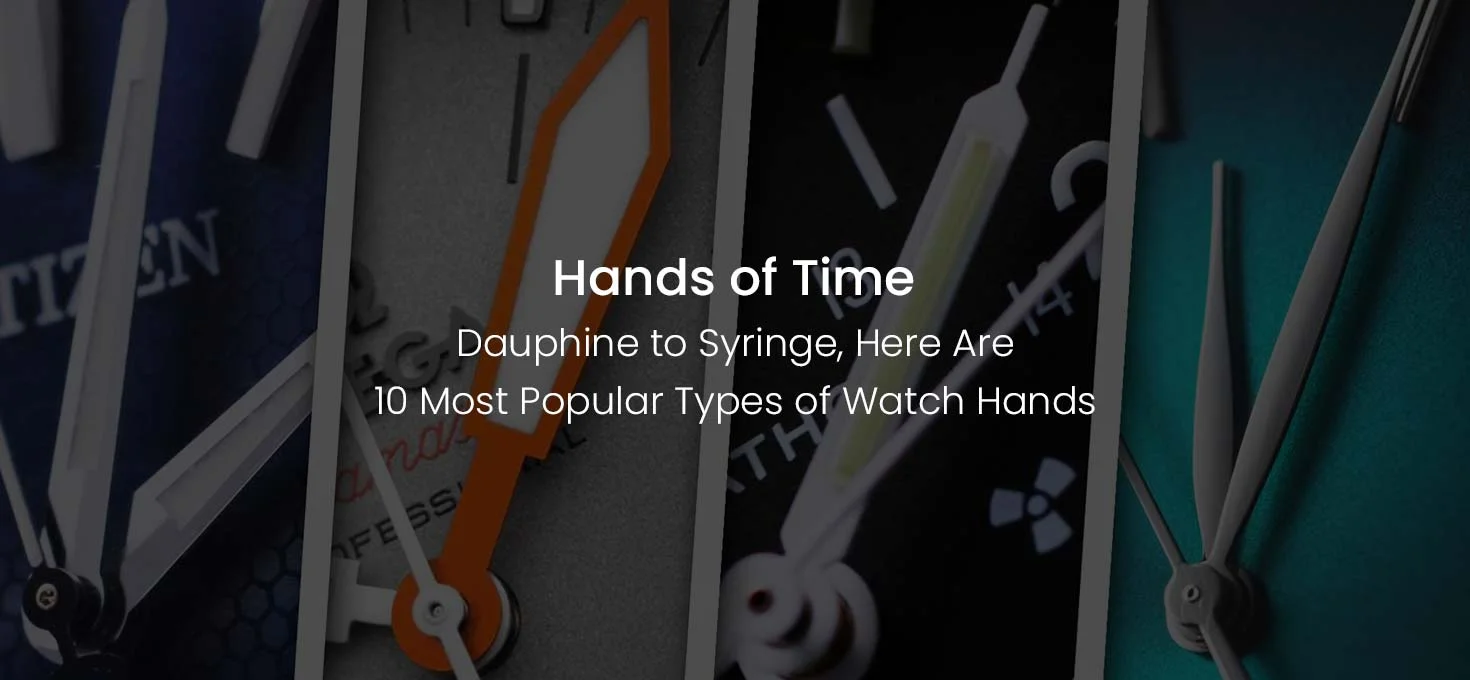 Reading Time: 5 minutes
Reading Time: 5 minutes
Unless you own Hublot’s mechanically Frankenstein-like MP-10 or one of MB&F’s horological wonders — chances are, your timepiece features a set of hands to indicate hours, minutes, and seconds. These watch hands cinch in a certain sense of character to timepieces, and for most brands, it’s like a religion, leaving no room for misinterpretation. While this may seem like quite a rudimentary or careful avenue of design, watch brands have been getting audaciously creative with watch hands off late. Take OMEGA’s latest Speedmaster, which houses a tiny Saturn V-inspired rocket ship for a chronograph hand, Gérald Genta’s timeless Mickey Mouse iterations, or Konstantin Chaykin’s ‘Joker’ which features a pair of irises for minutes and hands. These one-offs certainly capture one’s attention, but otherwise, the industry has a staple menu of watch hands they pick/mix and match from. Here’s your guide to understanding the many types of watch hands, which genre of luxury watchmaking they belong to, and where they came from.
Breguet Hands
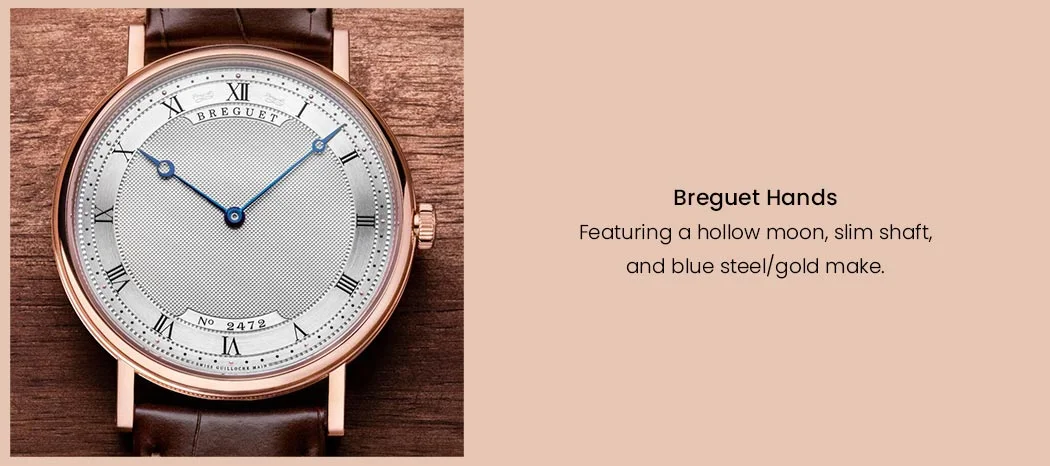
Let’s start with a creation by the ‘Leonardo da Vinci of watchmaking’ himself — Sir Abraham-Louis Breguet, founder of the eponymous luxury watch maison and mastermind behind a plethora of revered horlogerie feats like the tourbillon. Gracing all these innovations were in-house-designed ‘Breguet hands’, which first appeared in 1783, featuring a hollow moon, slim shaft, and blue steel/gold make. Commonly accompanied by Roman or Arabic numeral indexes, they create a vintage, timelessly classy appearance. They’ve also been featured in models of other brands like Patek Philippe, Frederique Constant, and Longines.
Alpha Hands
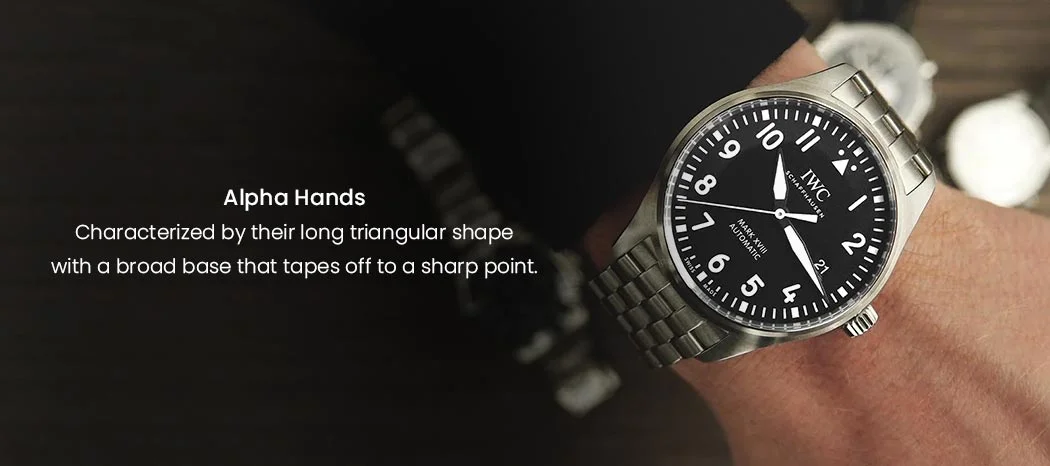
Adding in a sense of objective and functionality are Alpha Hands. Typically found on heavily complicated or utility-focused timepieces, like IWC’s Big Pilot or A. Lange & Söhne’s Datograph Perpetual Tourbillon. They can be characterized by their long triangular shape with a broad base that tapes off to a sharp point. Unlike Sword hands, whose minute and hour hands look polarly different, Alpha hands retain a common design profile — differentiated only by size. These hands serve a singular purpose – legibility in reading time
Arrow Hands
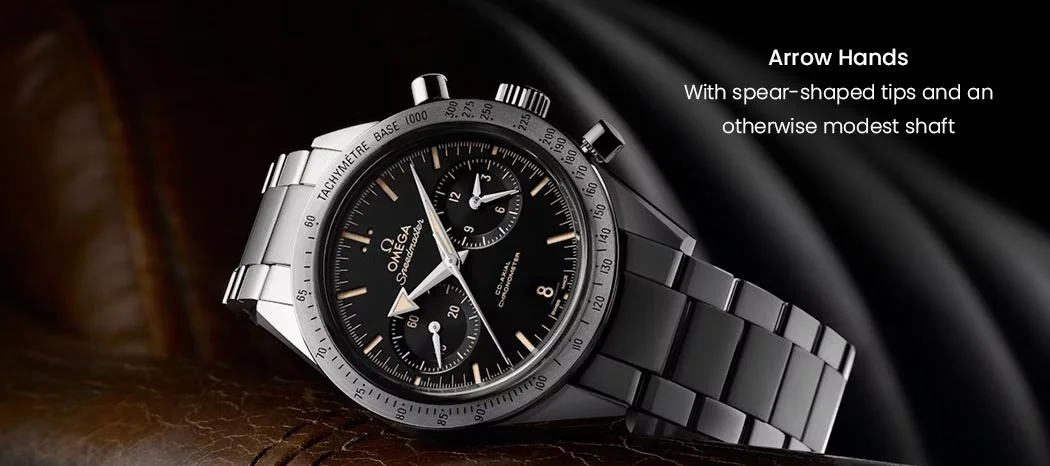
With spear-shaped tips and an otherwise modest shaft, Arrow hands certainly offer a splash of sportiness. Spotted famously on the Omega Seamaster and Speedmaster models, they focus on functionality and practicality, seeking legibility. Only the hour hand is often arrow-tipped, while the minute hand is typically sword-like. Arrow hands are a common feat of sporty, chronograph watches.
Baton Hands & Pencil Hands
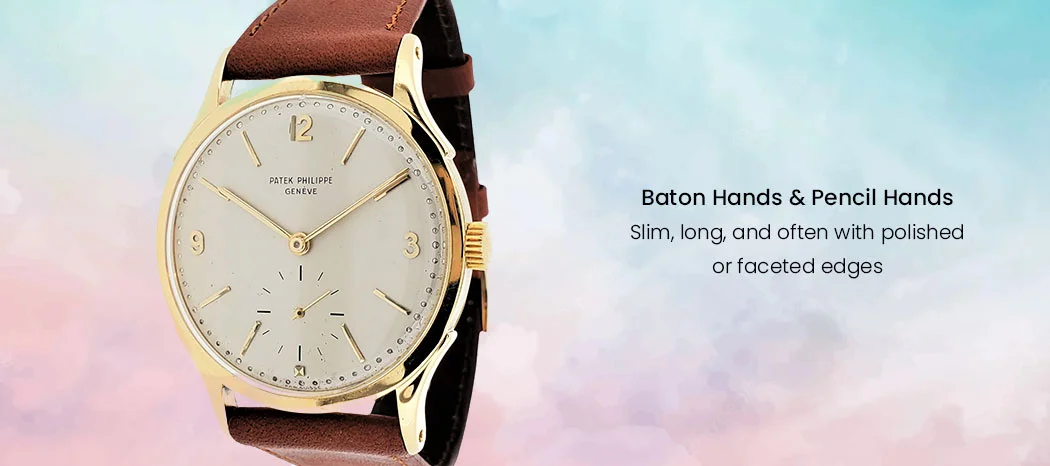
Slim, long, and often with polished or faceted edges, Baton hands emphasize minimalism and fuss-free elegance. At first glance, you may expect Baton watches to be a dress watch staple, however, they’ve been a signature feat of the Patek Philippe Nautilus and Audemars Piguet Royal Oak since their inception. Reflecting a note of quiet luxury, their craftsmanship typically dabbles with precious metals, enhancing its visual appeal.
Its sibling is Pencil hands, which are only differentiated by triangular-shaped tips. Retaining the straightforward geometric approach of baton hands, it takes after the shape of a pencil – sleek, long, and pointy at the end. The Longines Spirit collection and Hublot Classic Fusion are examples of its use.
Cathedral Hands
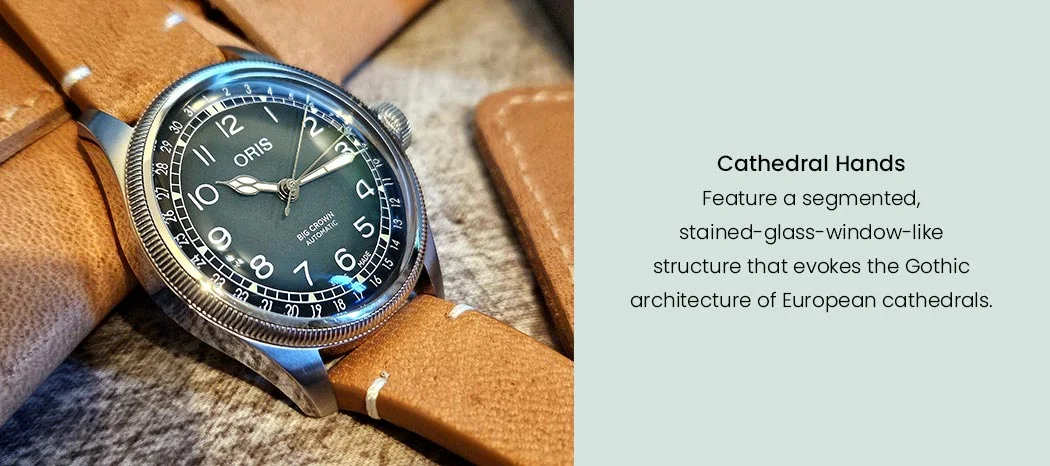
Cathedral hands feature a segmented, stained-glass-window-like structure that evokes the Gothic architecture of European cathedrals. Typically found in pilot’s watches, military chronographs, and dress watches, this unique style of watch hands balances 20th-century reverence with practicality. Featuring a bulbous-headed hour hand reminiscent of a bishop’s mitre, the minute hand takes a comparatively simpler approach. The objective here is to differentiate between the two at a single glance. One of my favourite examples of the use of Cathedral hands is ORIS’ Big Crown collection.
Dauphine Hands
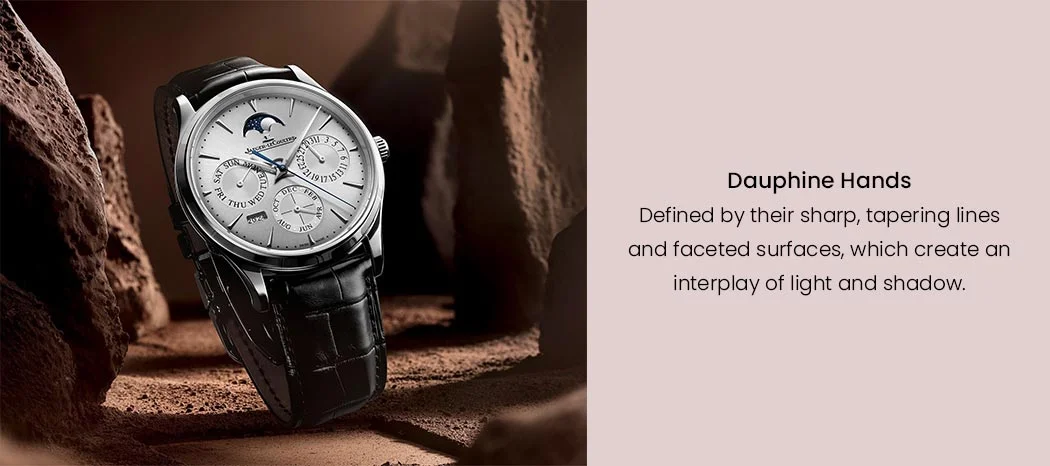
Dating back to the 1930s, its etymology comes from ‘dauphin’ – French for ‘eldest son of the king’. We would’ve guessed its connection to the sea mammal, perhaps due to the silhouette it evokes. Turns out, the crest of the French crown prince’s coat-of-arms featured two dolphins, hence the shorthand. In form, Dauphine hands are defined by their sharp, tapering lines and faceted surfaces, which create an interplay of light and shadow. The Jaeger-LeCoultre Reverso and Longines Conquest Heritage series are champions in using Dauphine hands.
Feuille Hands (Leaf Hands)
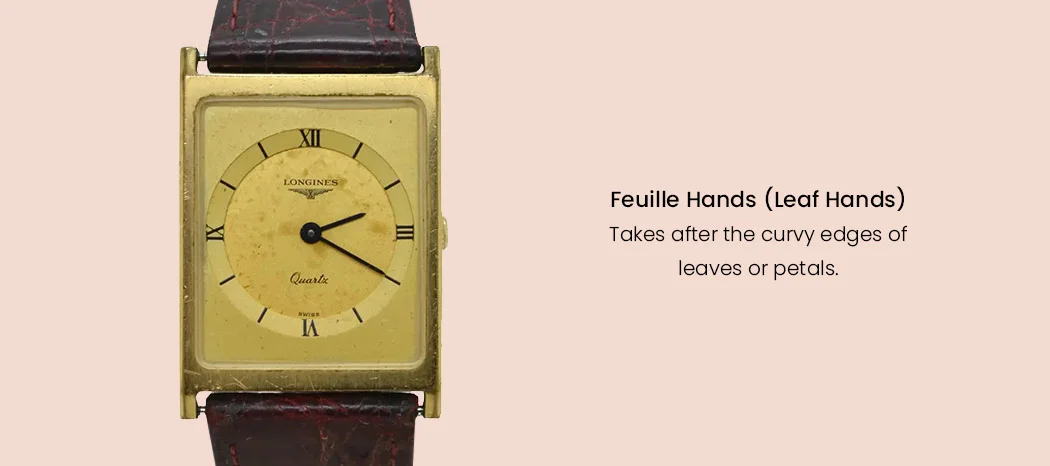
The French, of course, wouldn’t stop at one. Feuille hands, which translates to ‘leaf’ in French, takes after the curvy edges of leaves or petals. Thin at its stem, it widens in between, only to taper off towards the end. We’ve spotted this curvilinear type of hand on plenty of dress watches like the IWC Portofino and Longines Evidenza/Master Collection. It’s effortlessly classy and exudes timeless luxury, the same reason why it’s a dress watch staple. This is often used as hands for sub-dials, particularly in complications like power reserve indicator, day/date, or chronographs.
Syringe Hands
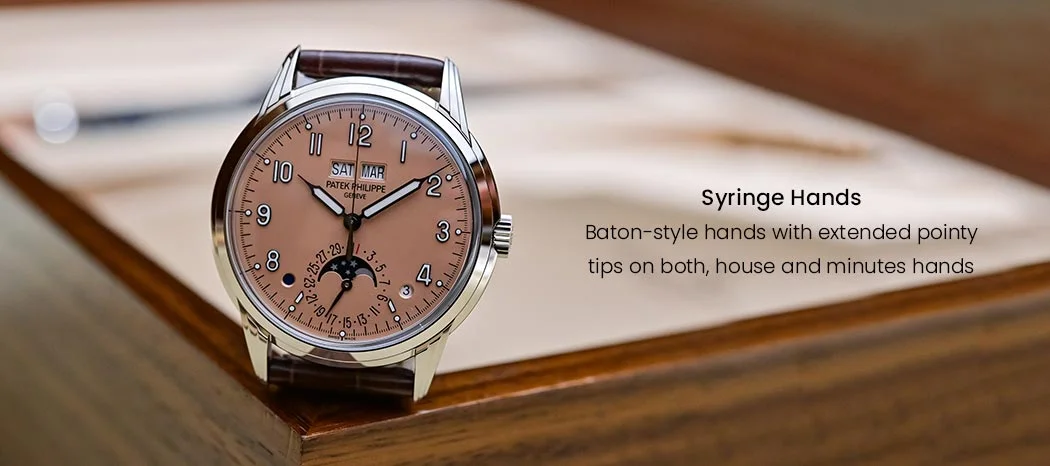
For most, syringes or needles have always been intimidating – but here’s one you’ll love. These baton-style hands with extended pointy tips on both, house and minutes hands have been around since the 1930s and are popularized to date by Patek Philippe’s extensive use in their Grand Complications collection and Breitling’s Premier collection. These medical-instrument-like hands materialize the intersection between Art Deco design and functionality, offering legibility and elegance.
Sword Hands
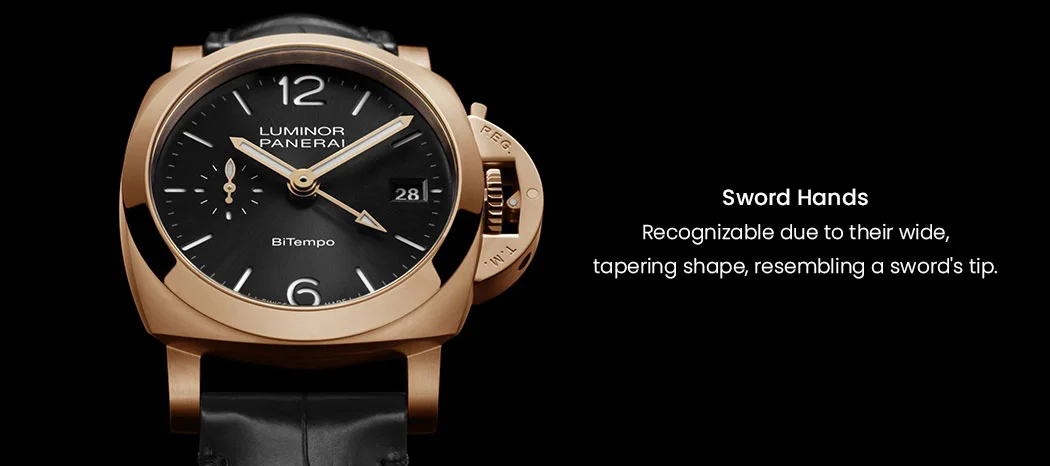
Sturdy and bold, sword hands are versatile and instantly recognizable due to their wide, tapering shape, resembling a sword’s tip. The archives aren’t giving us a clear timestamp of when Sword hands were introduced but they gained popularity just around World War I. While the Sword hands of the Cartier Santos Dumont and Ballon Bleu exude elegance, the Sword hands of the Omega Seamaster Diver and Panerai Submersible offer legibility in a diver’s watch. In form, these hands begin slim and gradually get thicker towards the end – oftentimes, they’re skeletonized with ridges and luminescent tips.
The post Hands of Time: Dauphine to Syringe, Here Are 10 Most Popular Types of Watch Hands appeared first on Kapoor Watch Co. | Blogs.






